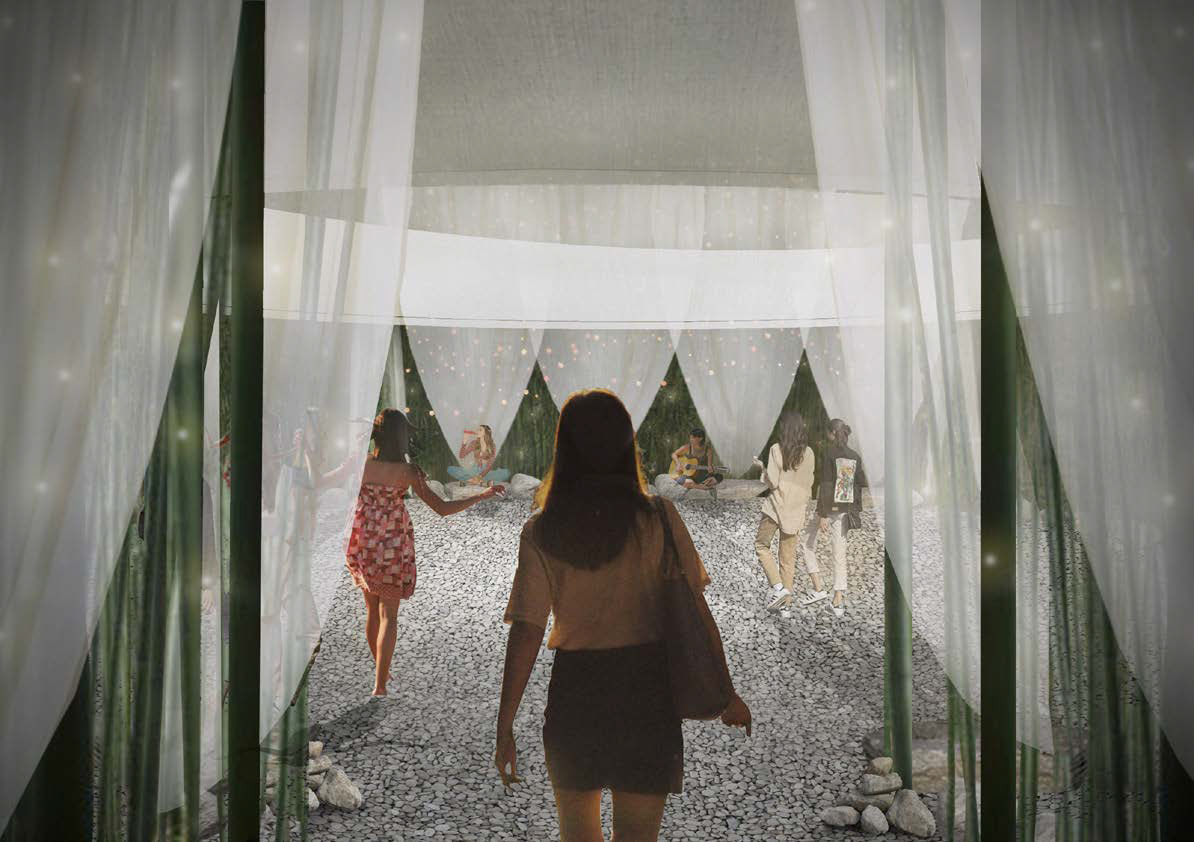


Our team decided to focus on bamboo, a widely-available local material in Thailand, and began investigating its growth patterns and uses. We also studied traditional techniques that locals utilize in bamboo construction. The insights we gleamed, along with our own design innovation, resulted in the application of minimally-disruptive techniques in the construction of pavilion-style recreational structure that evolves and reshapes its surroundings with time (Scan QR for concept video).
 (conceptual image)
(conceptual image)Team with Gianmaria Socci and Kan Vajaranant
THE FOREST PAVILION
Top-20 shortlisted entry for Wonderfruit International Design CompetitionThe Forest is a building.
The Forest is not a building.
Paradoxical indeed—but true in every sense.
Our encroachment into natural space to expand our man-made territories—territories we deem as necessary for our own development—is not only an ongoing but also an accelerating process. However, with over a billion hectares of forest rapidly cut down in the past 40 years, what we lost is not simply “trees” but also “living habitats”, “biodiversity”, and “valuable carbon storage”.
There is a clear dilemma between human desire and environmental conservation, between man-made architecture and natural landscape. Yet, the answer to this dilemma may not necessarily be a win-lose one: A rethinking of relationship between architecture and nature may suggest a win-win solution.
In our project “The Forest”, architecture is not a foreign agent of natural destruction but a framework that defines a minimally controlled space of co-existence of humans and nature. Taking advantage of nature and its property—in this case, the growth patterns of bamboo through its lifespan—“The Forest” represents a living architectural landscape that grows and evolves with the continuous expansion of surrounding bamboo forest. While “The Forest” has a clearly defined beginning, it has no definite end: “The Forest” will eventually dissolve into the natural ecosystem, its artificial marks blending seamlessly into the surrounding context.
In practice, “The Forest” Pavilion serves as a sustainable multi-purpose recreational space that links and perpetuates an environmental-conscious community in its enjoyment of the outdoor—in line with Wonderfruit’s concept of Super Green, Super Lean & Super Clean.



The far-left image illustrates a concept visualization of “The Forest” in the setting of Wonderfruit annual gatherings typically taking place at The Fields at Siam Country Club in Chonburi Province, Thailand.
“The Forest” Pavilion serves as one of the many recreational spots for Wonderfruit Community to explore wonders through art, culture, music, and nature.
Multiple entrance paths (like the one seen on top right image) lead to a central exhibition space. The path is like a trail in the forest, with stones lining up to create an informal boundary and with translucent canopy made of organzas vaguely defining the space while intermittently opening up to reveal the thick bamboo mass. Emanating a bohemian, mysterious vibe, the path aims to draw Wonderfruit participants into a trance of curiosity.
The ground topography gradually rises as participants walk towards the central opening and discovers a novel scene in the cavernous central exhibition space (right-middle image). The same lightweight, waterproof canopy runs around this space, hanging from the surrounding bamboo stems and relying on a central rigid rim (also built in bamboo). The space allows for great flexibility to introduce surprising elements for various activities, from concerts to art appreciation and food tasting events.
Many “Circular Pocket Spaces” adjacent to the central exhibition space open up towards the center like those small nodes branching out from the main system. Here, behind the curtains, hammock-like structures hang from the surrounding bamboo, providing an intimate break from communal activities.
Compared to fully-artificial structures, “The Forest” may indeed require longer set-up time. However, its evolving existence will also introduce more surprising elements for users through time—all while producing “new fruits” in the form of “next-generation bamboos” that may be used for various purposes in subsequent Wonderfruit annual gatherings.